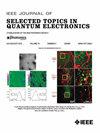基于功能近红外光谱测量的年轻人偏头痛检测
IF 5.1
2区 工程技术
Q1 ENGINEERING, ELECTRICAL & ELECTRONIC
IEEE Journal of Selected Topics in Quantum Electronics
Pub Date : 2025-02-26
DOI:10.1109/JSTQE.2025.3540761
引用次数: 0
摘要
本研究利用功能近红外光谱(fNIRS)研究了并发症较少的年轻人的神经血管反应。采用近红外光谱(fNIRS)对32例青年偏头痛患者和32例健康对照者的前额叶皮层(PFC)血红蛋白变化进行了观察。根据偏头痛患者额叶皮层的结构变化,设计了两个精神应激任务和一个注意力集中任务(CT)。统计结果显示,这三种任务都揭示了各组之间前额叶血氧的差异。具体来说,在脑力任务相关的练习中,左脑半球有显著差异,而在CT测试中,右脑半球有显著差异。此外,机器学习技术被应用于偏头痛分类,在心算任务(MAT)、语言流畅性任务(VFT)和CT上的测试准确率分别为82%、89%和90%。这些结果证明了利用fNIRS与机器学习对年轻人偏头痛进行分类的可行性。本文章由计算机程序翻译,如有差异,请以英文原文为准。
Migraine Detection in Young Group Based on Functional Near-Infrared Spectroscopy Measurements
This study investigated the neurovascular responses in young individuals with fewer complications using functional near-infrared spectroscopy (fNIRS). Thirty-two young migraines and thirty-two healthy control subjects (HC) were measured by fNIRS to observe changes in hemoglobin in the prefrontal cortex (PFC). According to the structural changes in the frontal cortex in migraine patients, two mental stress tasks and a concentration task (CT) were designed. The statistical findings showed that all three tasks revealed differences in prefrontal blood oxygenation between groups. Specifically, during the mental task-related exercises, a significant difference was identified in the left hemisphere, whereas during the CT, a notable distinction was noted in the right hemisphere. Furthermore, machine learning techniques were applied for migraine classification, receiving test accuracies of 82%, 89%, and 90% for the mental arithmetic task (MAT), the verbal fluency task (VFT), and the CT, respectively. These results demonstrate the feasibility of utilizing fNIRS with machine learning to classify migraines in young individuals.
求助全文
通过发布文献求助,成功后即可免费获取论文全文。
去求助
来源期刊

IEEE Journal of Selected Topics in Quantum Electronics
工程技术-工程:电子与电气
CiteScore
10.60
自引率
2.00%
发文量
212
审稿时长
3 months
期刊介绍:
Papers published in the IEEE Journal of Selected Topics in Quantum Electronics fall within the broad field of science and technology of quantum electronics of a device, subsystem, or system-oriented nature. Each issue is devoted to a specific topic within this broad spectrum. Announcements of the topical areas planned for future issues, along with deadlines for receipt of manuscripts, are published in this Journal and in the IEEE Journal of Quantum Electronics. Generally, the scope of manuscripts appropriate to this Journal is the same as that for the IEEE Journal of Quantum Electronics. Manuscripts are published that report original theoretical and/or experimental research results that advance the scientific and technological base of quantum electronics devices, systems, or applications. The Journal is dedicated toward publishing research results that advance the state of the art or add to the understanding of the generation, amplification, modulation, detection, waveguiding, or propagation characteristics of coherent electromagnetic radiation having sub-millimeter and shorter wavelengths. In order to be suitable for publication in this Journal, the content of manuscripts concerned with subject-related research must have a potential impact on advancing the technological base of quantum electronic devices, systems, and/or applications. Potential authors of subject-related research have the responsibility of pointing out this potential impact. System-oriented manuscripts must be concerned with systems that perform a function previously unavailable or that outperform previously established systems that did not use quantum electronic components or concepts. Tutorial and review papers are by invitation only.
 求助内容:
求助内容: 应助结果提醒方式:
应助结果提醒方式:


